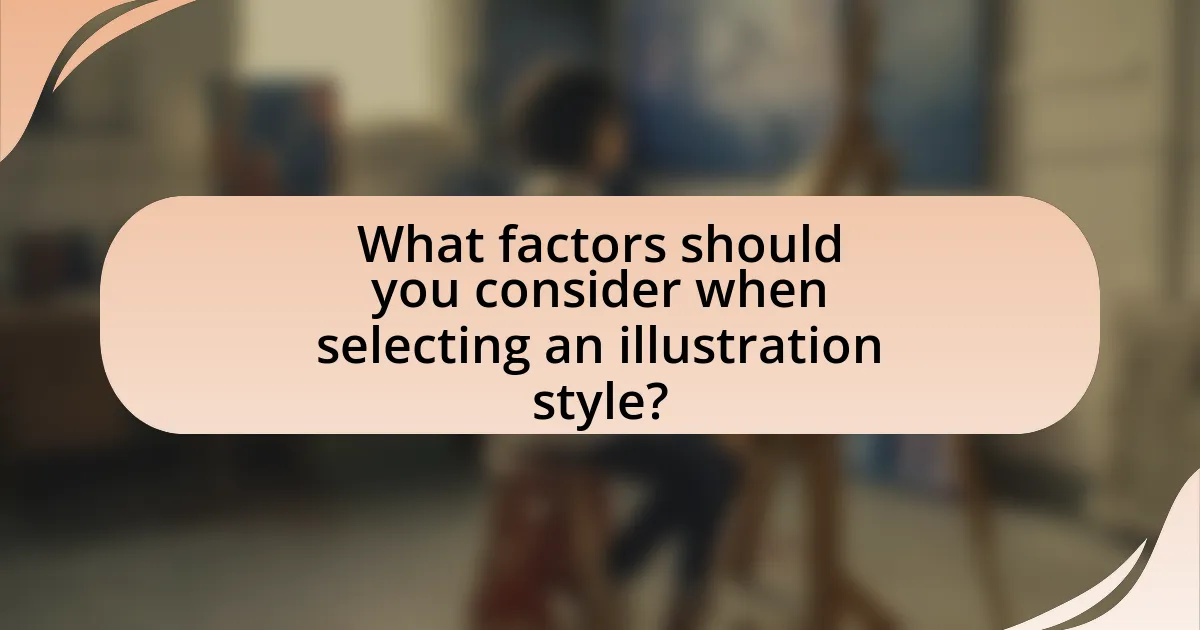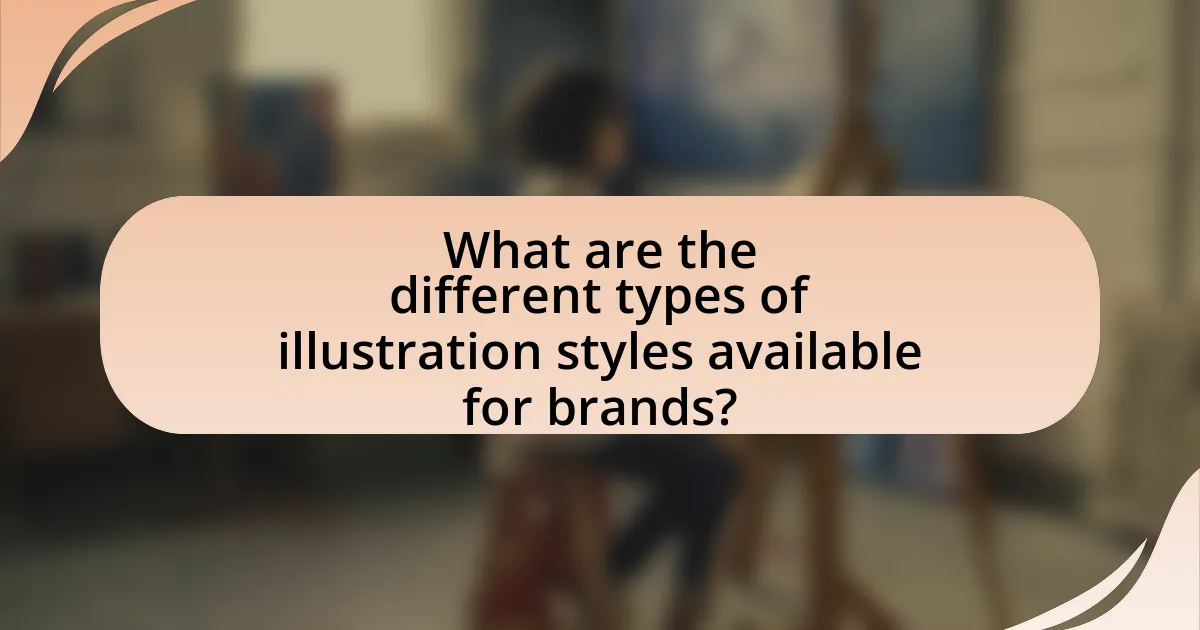Choosing the right illustration style for a brand is essential for influencing brand perception and audience engagement. This article explores the significance of aligning illustration styles with brand values, how different styles impact brand identity, and the elements that contribute to brand perception. It also discusses the importance of understanding target audience preferences, evaluating demographic factors, and utilizing audience feedback in the selection process. Additionally, the article highlights best practices for maintaining consistency across platforms and avoiding common pitfalls in branding.

What is the importance of choosing the right illustration style for your brand?
Choosing the right illustration style for your brand is crucial because it directly influences brand perception and audience engagement. A well-selected illustration style aligns with brand values and communicates the intended message effectively, enhancing recognition and recall. For instance, a study by the Nielsen Norman Group found that visual elements significantly impact user experience, with 93% of consumers considering visual appearance as a key factor in their purchasing decisions. Therefore, the appropriate illustration style not only differentiates a brand in a competitive market but also fosters emotional connections with the target audience, ultimately driving brand loyalty and sales.
How does illustration style impact brand identity?
Illustration style significantly impacts brand identity by visually conveying a brand’s values, personality, and message. A cohesive illustration style can enhance recognition and differentiate a brand in a crowded market; for instance, brands like Mailchimp use playful, cartoonish illustrations to reflect their approachable and friendly nature. Research indicates that consistent visual elements, including illustration styles, can increase brand recall by up to 80%, demonstrating the importance of aligning illustration with brand identity.
What elements of illustration contribute to brand perception?
Elements of illustration that contribute to brand perception include color, style, composition, and subject matter. Color influences emotional responses and can evoke specific feelings associated with the brand; for example, blue often conveys trust, while red can signify excitement. The style of illustration, whether it is minimalist, whimsical, or realistic, shapes how consumers relate to the brand’s personality. Composition affects visual hierarchy and guides the viewer’s attention, impacting how effectively the brand message is communicated. Lastly, subject matter reflects the brand’s values and target audience, ensuring relevance and resonance with consumers. These elements collectively shape the overall perception of a brand, influencing consumer engagement and loyalty.
How can illustration style differentiate a brand in the market?
Illustration style can differentiate a brand in the market by creating a unique visual identity that resonates with its target audience. A distinct illustration style can evoke specific emotions and associations, making the brand more memorable. For example, brands like Mailchimp use playful, cartoonish illustrations to convey a friendly and approachable image, which sets them apart from competitors that may use more traditional or corporate visuals. This differentiation is crucial in crowded markets, as it helps consumers quickly identify and connect with the brand’s values and personality.
Why is it essential to align illustration style with brand values?
Aligning illustration style with brand values is essential because it ensures consistency in brand messaging and enhances brand recognition. When illustrations reflect the core values of a brand, they create a cohesive visual identity that resonates with the target audience. For instance, a brand that emphasizes sustainability may use earthy tones and organic shapes in its illustrations, reinforcing its commitment to environmental responsibility. This alignment not only strengthens emotional connections with consumers but also differentiates the brand in a competitive market, as studies show that consistent branding can increase revenue by up to 23%.
What are the risks of misalignment between illustration style and brand values?
Misalignment between illustration style and brand values can lead to significant risks, including brand confusion, loss of customer trust, and diminished brand loyalty. When the visual representation does not align with the core values of the brand, it can create a disconnect that confuses consumers about what the brand stands for. For instance, a brand that promotes sustainability but uses overly flashy or extravagant illustrations may appear insincere, leading to skepticism among environmentally conscious consumers. Additionally, research indicates that consistent brand messaging, including visual elements, can increase customer retention by up to 23%. Therefore, failing to align illustration style with brand values can ultimately harm a brand’s reputation and financial performance.
How can a cohesive illustration style enhance brand storytelling?
A cohesive illustration style enhances brand storytelling by creating a unified visual language that resonates with the audience. This consistency helps to convey the brand’s values, personality, and message more effectively, making it easier for consumers to connect emotionally with the brand. Research indicates that brands with a consistent visual identity can increase customer recognition by up to 80%, which reinforces the importance of a cohesive illustration style in establishing a memorable narrative.

What factors should you consider when selecting an illustration style?
When selecting an illustration style, consider the brand identity, target audience, and the message you want to convey. Brand identity dictates the visual representation that aligns with your values and personality, while understanding the target audience ensures the style resonates with their preferences and expectations. The message influences the tone and emotional response you aim to evoke, guiding the choice of colors, shapes, and overall aesthetics. For instance, a playful brand may opt for whimsical illustrations, whereas a luxury brand might choose a more refined and minimalist style.
How do target audience preferences influence illustration style choice?
Target audience preferences significantly influence illustration style choice by dictating the visual language that resonates with them. For instance, a younger audience may prefer vibrant, playful illustrations, while a more mature demographic might favor sophisticated, minimalist designs. Research indicates that 70% of consumers are more likely to engage with brands that use visuals aligned with their preferences, demonstrating the importance of tailoring illustration styles to audience expectations. This alignment not only enhances brand relatability but also fosters emotional connections, ultimately driving consumer loyalty and engagement.
What demographic factors should be analyzed for effective illustration style selection?
To select an effective illustration style, demographic factors such as age, gender, cultural background, and education level should be analyzed. Age influences preferences for visual complexity and themes; for instance, younger audiences may favor vibrant, modern styles, while older demographics might prefer classic, subdued illustrations. Gender can affect color choices and subject matter, as studies show that men and women often respond differently to visual stimuli. Cultural background plays a crucial role in symbolism and imagery, as certain styles may resonate more with specific cultural groups. Education level can impact the audience’s familiarity with artistic styles, influencing their preferences for abstract versus realistic illustrations. Analyzing these demographic factors ensures that the chosen illustration style aligns with the target audience’s expectations and enhances engagement.
How can audience feedback shape the illustration style decision?
Audience feedback can significantly influence the illustration style decision by providing insights into preferences and emotional responses. When audiences express their likes or dislikes regarding specific styles, brands can analyze this feedback to align their visual identity with audience expectations. For instance, a study by Nielsen Norman Group found that user-centered design, which incorporates audience feedback, leads to higher satisfaction and engagement rates. This demonstrates that understanding audience reactions can guide brands in selecting illustration styles that resonate more effectively with their target market.
What role does brand personality play in choosing an illustration style?
Brand personality significantly influences the selection of an illustration style by aligning visual representation with the brand’s character traits. For instance, a brand that embodies playfulness may opt for vibrant, whimsical illustrations, while a brand that conveys sophistication might choose minimalist and elegant designs. This alignment ensures that the illustration style resonates with the target audience, enhancing brand recognition and emotional connection. Research indicates that consistent brand personality across visual elements can increase consumer trust and loyalty, as seen in studies by Aaker (1997) on brand equity, which highlight the importance of congruence between brand attributes and visual representation.
How can different illustration styles reflect various brand personalities?
Different illustration styles can effectively reflect various brand personalities by visually communicating the brand’s values, tone, and target audience. For instance, a minimalist illustration style often conveys sophistication and modernity, appealing to luxury brands, while vibrant and playful illustrations can represent a fun and youthful brand personality, attracting a younger demographic. Research indicates that visual elements significantly influence consumer perception; a study published in the Journal of Consumer Research found that congruence between visual style and brand personality enhances brand recall and preference. Thus, selecting an illustration style that aligns with the desired brand identity is crucial for effective brand communication.
What are examples of brands that successfully match their illustration style with their personality?
Brands that successfully match their illustration style with their personality include Mailchimp, Airbnb, and Dropbox. Mailchimp utilizes playful and quirky illustrations that reflect its friendly and approachable brand personality, enhancing user engagement. Airbnb employs warm and inviting illustrations that convey a sense of community and belonging, aligning with its mission to connect travelers with unique experiences. Dropbox features clean and minimalistic illustrations that emphasize simplicity and efficiency, mirroring its focus on user-friendly technology. These brands effectively use their illustration styles to reinforce their core values and resonate with their target audiences.

What are the different types of illustration styles available for brands?
There are several types of illustration styles available for brands, including flat design, line art, watercolor, 3D illustration, and vintage illustration. Flat design features minimalistic elements with bold colors and simple shapes, making it effective for modern branding. Line art utilizes clean, continuous lines to create images, often conveying elegance and simplicity. Watercolor illustrations provide a soft, artistic touch, appealing to brands that want to evoke emotion and creativity. 3D illustrations offer depth and realism, suitable for tech and product-focused brands. Vintage illustration draws on retro aesthetics, often appealing to brands that want to evoke nostalgia. Each style serves distinct branding purposes and can significantly influence consumer perception.
What are the most popular illustration styles used in branding?
The most popular illustration styles used in branding include flat design, line art, and 3D illustrations. Flat design is characterized by minimalistic elements and vibrant colors, making it visually appealing and easy to recognize, which is crucial for brand identity. Line art, known for its simplicity and elegance, often conveys a modern and sophisticated feel, allowing brands to communicate messages clearly. 3D illustrations add depth and realism, engaging audiences through dynamic visuals that can enhance storytelling. These styles are widely adopted because they effectively capture attention and convey brand values, as evidenced by their frequent use in successful branding campaigns across various industries.
How does flat design differ from 3D illustration in branding?
Flat design differs from 3D illustration in branding primarily through its use of minimalism and two-dimensional elements, while 3D illustration incorporates depth and realism. Flat design emphasizes simplicity, often utilizing bold colors and clean lines to create a modern aesthetic that enhances user experience and brand recognition. In contrast, 3D illustration provides a more immersive and dynamic visual experience, often used to convey complex ideas or products in a more relatable manner. This distinction is evident in branding strategies; for example, companies like Google and Apple utilize flat design for their interfaces to promote clarity and ease of use, while brands like Coca-Cola may employ 3D illustrations in advertising to evoke emotion and engagement through lifelike representations.
What are the characteristics of hand-drawn illustrations in brand identity?
Hand-drawn illustrations in brand identity are characterized by their unique, personal touch, which conveys authenticity and creativity. These illustrations often feature irregular lines, organic shapes, and a sense of imperfection that differentiates them from digital designs, making brands appear more approachable and relatable. Additionally, hand-drawn illustrations can evoke nostalgia and warmth, appealing to emotional connections with consumers. Research indicates that brands utilizing hand-drawn elements can enhance customer engagement by fostering a sense of community and individuality, as seen in successful campaigns by companies like Innocent Drinks and Ben & Jerry’s.
How can you evaluate which illustration style resonates best with your brand?
To evaluate which illustration style resonates best with your brand, conduct audience research and analyze competitor styles. Audience research involves gathering feedback through surveys or focus groups to understand preferences and emotional responses to different styles. Analyzing competitor styles helps identify industry trends and successful visual strategies. For instance, a study by Nielsen Norman Group found that user engagement increases when visuals align with user expectations, indicating that matching illustration styles to audience preferences can enhance brand connection.
What tools and methods can be used to test illustration style effectiveness?
To test illustration style effectiveness, tools and methods such as A/B testing, surveys, focus groups, and analytics can be utilized. A/B testing allows for direct comparison of different illustration styles by measuring user engagement and conversion rates. Surveys can gather qualitative feedback from target audiences regarding their preferences and perceptions of various styles. Focus groups provide in-depth discussions that reveal emotional responses and insights into audience preferences. Additionally, analytics tools can track user interactions with illustrations across digital platforms, providing quantitative data on effectiveness. These methods collectively offer a comprehensive approach to evaluating how well an illustration style resonates with the intended audience.
How can A/B testing help in selecting the right illustration style?
A/B testing can help in selecting the right illustration style by allowing brands to compare the performance of different styles in real-time with their target audience. By presenting two or more variations of illustrations to users and measuring engagement metrics such as click-through rates, conversion rates, or user feedback, brands can identify which style resonates more effectively. For instance, a study by Optimizely found that A/B testing can lead to a 20% increase in conversion rates when the preferred design is implemented based on user preferences. This data-driven approach ensures that the chosen illustration style aligns with audience expectations and enhances brand communication.
What are some best practices for implementing your chosen illustration style?
To effectively implement your chosen illustration style, ensure consistency across all brand materials. Consistency reinforces brand identity and helps in recognition; for instance, using the same color palette, line thickness, and character design in various applications strengthens the visual narrative. Additionally, adapt the illustration style to fit different formats, such as digital and print, while maintaining the core elements of the style. This adaptability is crucial as studies show that cohesive branding can increase revenue by up to 23%. Lastly, gather feedback from your audience to refine the style, as audience engagement can provide insights that enhance the effectiveness of the illustrations.
How can consistency be maintained across different platforms with your illustration style?
Consistency can be maintained across different platforms with your illustration style by establishing a clear set of guidelines that define color palettes, typography, and visual elements. These guidelines ensure that all illustrations reflect the same aesthetic and thematic qualities, regardless of the platform. For instance, using a specific color palette consistently across social media, websites, and print materials reinforces brand identity. Research shows that consistent branding can increase revenue by up to 23%, highlighting the importance of uniformity in visual representation.
What common pitfalls should be avoided when applying an illustration style to branding?
Common pitfalls to avoid when applying an illustration style to branding include inconsistency in style, neglecting target audience preferences, and failing to align with brand values. Inconsistency can confuse consumers and dilute brand identity, as seen in companies that switch styles frequently, leading to a lack of recognition. Neglecting audience preferences can result in illustrations that do not resonate, as demonstrated by brands that fail to engage their demographic effectively. Lastly, illustrations that do not reflect brand values can mislead consumers, undermining trust; for instance, a brand promoting sustainability should avoid using overly industrial or wasteful imagery.


